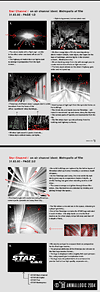How they work

Toby works with other designers, modellers and animators to respond to requests from clients for visual effects in film or TV. The projects he works on range from logos and identities for TV stations to effects on large feature films. While the size of the budget and the end products may look different, the process the team follows to develop their ideas onto the screen are usually fairly similar.
How they do it: the design process
A project Toby worked on recently was for a Japanese cable TV channel. The channel wanted a new identity and brand, and asked Toby and the Animal Logic team to develop it. The client didn't have many design criteria, they just wanted an exciting look and image for the station. The designers had to develop logos for packaging and letterheads, as well as animated station ID advertisements for four different cable TV channels.
"It was very open. They were just open for ideas, pretty much they just wanted it to feel like expensive Hollywood, make it look modern. It's just got to say ?Movies! Movies! Movies!' The whole thing, that was pretty much it."
Toby and another designer brainstormed lots of ideas for the logos and ID advertisements. Toby came up with an idea for the station ID advertisement ? he wanted to create a city made of film. He presented the idea to the client who approved the basic drawings and storyboards of the idea. Toby had to research film, what it looked like and how it moved. He needed to work out what a city made of film might look like. The team then had to work out how to do it.
 |
"What we were trying to do was sort of hard technically. We were trying to create a city made of film. It created a lot of lighting issues. It was technically a hard job in 3D, which I think is good. If it was easy every time you did it, you would stop doing it. Every job we get we try and do something new or push it a little bit further."
The designers worked with 3D animators to develop the animation. They developed a rough animation called an animatic, to show the client what it might look like and get their approval. To create the final animation, the team used powerful silicon graphics based workstations, called flame suites, to put all the different parts of the animation together.
"A really beautiful, abstract city made of film? almost like a really thin delicate quite expansive structure with a lot of energy in it. That was really what we were aiming for, and that's what we did."
Teamwork is an important part of the design process for visual effects design. For the Star Channel project Toby worked in a small team with a designer, five 3D animators and modellers and two compositors who put the final piece together.
"In this industry teamwork is crucial. In any project in a company structure you have to be able to get on with your fellow workers. If you look at any film project there are thousands of people involved in the film, whether it be pre-production, on the shoot or post-production. And that goes with TVC and motion graphics jobs. Every step of the way you have to work with other people. You have got to be easy to get on with and be able listen to other peoples? views, collaboration is the backbone to what goes on really."


